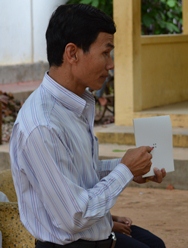An operational study was recently carried out in Cambodia to explore how ready-made spectacles (or self-adjustable specs) can be provided as part of existing health screening and referral programmes.
In collaboration with the
International Agency for the Prevention of Blindness (IAPB) Imperial College London's Partnership for Child Development (PCD) brought together the Global Partnership for Education (GPE), the
World Bank, and
Sightsavers to develop the initial operational study which ran from May to June 2012.
 Child vision often results in reduced participation in education leading to increased absenteeism, increased dropout rates, reduced ability to learn and poorer career prospects.
Child vision often results in reduced participation in education leading to increased absenteeism, increased dropout rates, reduced ability to learn and poorer career prospects.
The initial target for the project to screen 10,000 children from an estimated enrolment of 12,000 children aged 11-15 years in 56 schools across Siem Reap and Chi Kreng districts was exceeded with 13,175 screened over the four week period. As expected most children had vision within the normal range (99%) with the most common cause of vision impairment being uncorrected refractive error.
T
he Cambodia programme was carried out in close collaboration with the Cambodian Ministry of Education & Training and the Ministry of Planning and was informed by an international technical advisory group comprising eye health specialists, school health programme implementers and the IAPB.
Partners hope to use the results of this pilot study to inform a wider eye health implementation programme in five or six other countries with a specific focus on the use of schools as a point-of-entry to the community. If appropriate versions are available, adjustable spectacles will be included in these studies to assess their potential role in improving access to eye care in resource-poor settings.
PCD and IAPB were originally positioned to bring together the organisations at the
2nd Oxford Conference on Vision for Children in the Developing World held in April 2011.
Since 2007 PCD has supported research into 'self-refraction’, the process of users setting their own prescription through innovative adjustable spectacles as a model to provide spectacles for children through schools.

